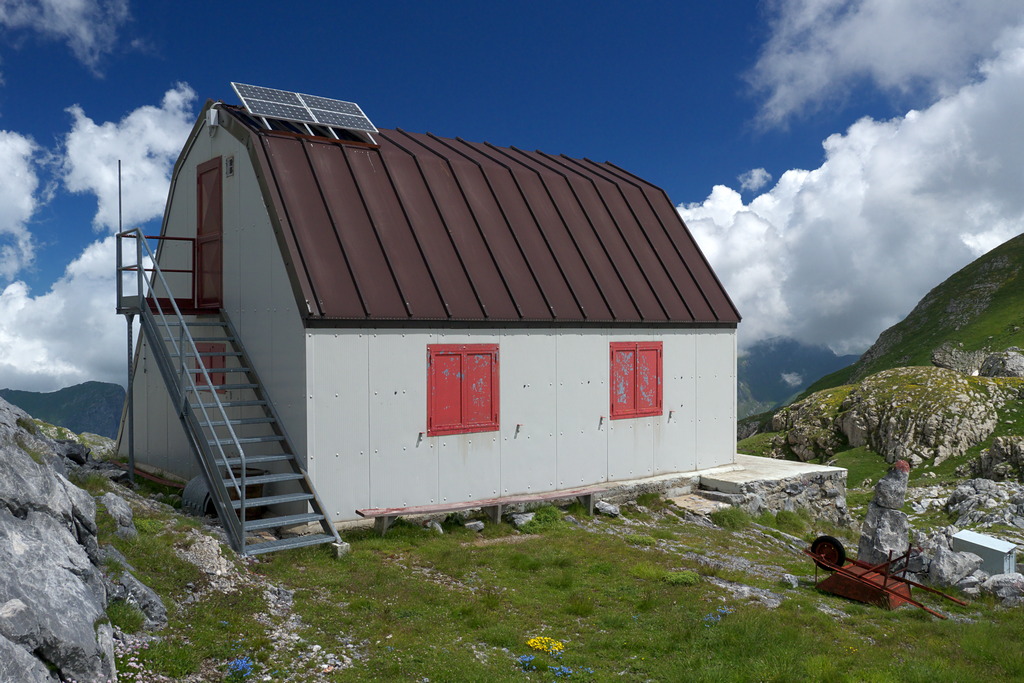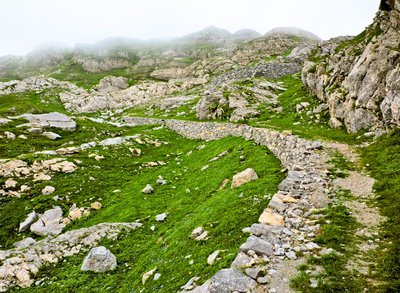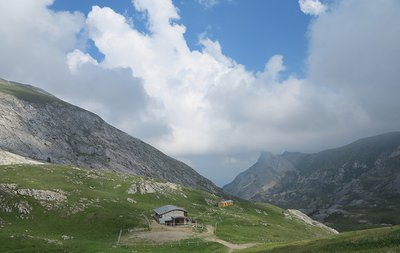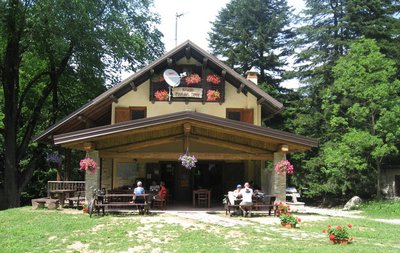
5. Giro del Marguareis, stage 05: from Refuge Don Barbera to Refuge Pian delle Gorre
2 points of interest

Un tratto della strada ex militare 194 - Archivio EAM  History and historical trail
History and historical trailThe invasion road
The former military road 194 (also known as the Invasion Road) should have connected the Certosa di Pesio with the Colle della Boaria. Begun
in 1940, as a matter of urgency, work was interrupted in September 1941, with several sections still unfinished.
It was considered of dubious strategic utility by some, indeed it could have facilitated a possible invasion by the French, by others it was considered a road built with the aim of opening an Italian attack route towards France.
[Le strade dei cannoni, pp.219-224]
La Conca delle Carsene - Archivio EAM  Geology
GeologyLa Conca delle Cársene
The Conca delle Càrsene is a vast plateau consisting of limestone rocks, characterized by expanses of bare, white rocks alternating with grassy cover.
It manifests the typical aspects of karst areas with limestone pavement, dolines and sinkholes. A superficial hydrographic network is completely missing: rain and snow meltwater are immediately absorbed and give rise to the resurgence of Pis del Pesio, located several hundred metres below.
Curiously, there are also areas located beyond the Alpine watershed, such as Plan Ambreuge, that are part of the catchment area, so water falling south of the Alps, after an underground journey, flow out on the Italian side.[Alpi Liguri, p.80]
[La Guida del Parco Alta Valle Pesio e Tanaro, pp.46-47]
Description
Arrived in the karstic basin of Plan Ambreuge (Pian Ambrogi, 2107 m, 0h40 from Don Barbera refuge) turn right into the meadows (post).
We leave on the right the path for the Col de Scarason, we turn to the left and we cross a deep bend. Now going west, we arrive at a fork near the ruins of a barracks, where we climb to the right, near the depression of the Colla Piana de Malaberga (2219 m, 1h05 of Plan Ambreuge)
After the pass the mule track is divided in two: the two branches meet, but it is better to choose the one on the left, which passes near the Cabane Morgantini (2219 m).
The mule track goes down to the edges of the Cuvette des Carsene, then, by a long semi-circle from left to right, goes around the pasture basin of the Gias de l'Ortica (1860 m).
On the left we leave two paths, respectively for the Col du Carbone and for the Col de Baban, and then, the ascent started, we ignore on the right the trace for the Col Scarason also and we arrive at the Col du Duc (1989 m, 1h45 of the Colla Piana de Malaberga), the narrow notch which gives access to the Pesio Valley.
After the pass a steep path goes down to the next fork, where you stay on the right to reach the Col du Prel supérieur (1926 m). Here, we ignore the fork on the right for the Vallon du Marguareis and we go down on the left, along the steep path that leads to the layout of an old ex-military road.
We descend into the Vallon des Arpi by very long bends and, now in the forest, we arrive at the Gias des Arpi (1435 m, 1h15 from the Col du Duc, fountain).
The fork on the left for the ignored Gias Fontana, a long descent on a gentle slope bypasses a ridge and leads to the thalweg of the Vallon du Saut. We cross the Torrent du Saut on a wooden footbridge, then another branch of the torrent using the wooden bridge on the right.
We quickly reach the esplanade where the dirt road coming from Pian delle Gorre ends. We leave on the right the path for the Refuge Garelli and we go down on the road until the clearing of Pian delle Gorre (1032 m, 1h05 from Gias des Arpi).
- Departure : Rifugio Don Barbera (2079 m)
- Arrival : Rifugio Pian delle Gorre (1032 m)
- Towns crossed : Briga Alta, La Brigue, and Chiusa di Pesio
Altimetric profile
Recommandations
Transport
https://www.savgroup.it/linee/43.pdf
SNCF line TER Provence Alpes-Côte d'Azur For travel in the PACA region and towards Cuneo www.ter-sncf.com/pac
Trenitalia for travel in the Piedmont region https://www.trenitalia.com/it.html
Report a problem or an error
If you have found an error on this page or if you have noticed any problems during your hike, please report them to us here:
Close by2
- Mountain Hut
Mountain Hut
Rifugio Don Barbera
The current structure, in stone and wood, is the result of a complete renovation recently carried out. It is a comfortable refuge, suitable for hikers as well as for groups and schools.
The refuge is located a few meters from the Colle dei Signori, immersed in the austere and uncontaminated nature of the upper Pesio and Tanaro valley natural park.


